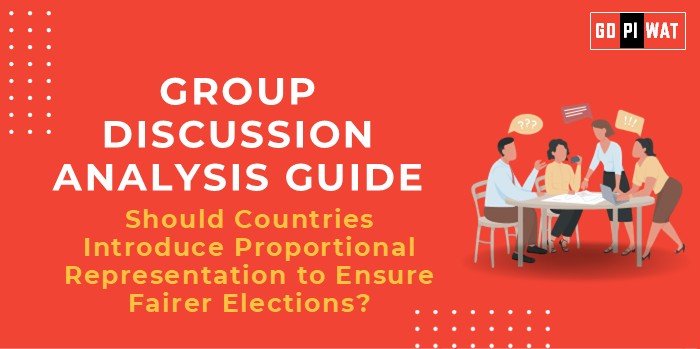📋 Group Discussion Analysis Guide
🌐 Should Countries Introduce Proportional Representation to Ensure Fairer Elections?
📖 Introduction to Proportional Representation
Opening Context: Electoral systems shape democratic outcomes. Proportional representation (PR) is gaining attention globally as an alternative to majoritarian systems, promising inclusivity and fairer representation.
Topic Background: PR allocates seats proportionally based on the share of votes each party receives, contrasting with first-past-the-post (FPTP) systems. With varying implementations worldwide, PR seeks to ensure diverse voices in governance.
📊 Quick Facts and Key Statistics
- 🌍 Countries Using PR: Over 85 nations, including Germany, Sweden, and South Africa, adopt proportional representation, enhancing political inclusivity.
- 📈 Voter Turnout Impact: PR systems often record higher voter turnouts, with averages around 70% compared to FPTP systems’ 60%.
- 🔍 Representation Accuracy: PR systems reduce the “wasted vote” phenomenon, ensuring minority voices matter.
- 🏆 Global Rankings: 7 of the top 10 nations in the Democracy Index use PR systems.
👥 Stakeholders and Their Roles
- Governments: Implement reforms, draft legislation, and monitor impact.
- Political Parties: Adapt strategies to appeal to a broader electorate.
- Civil Society and Voters: Advocate for inclusivity and fair representation.
- International Organizations: Provide frameworks and best practices.
✅ Achievements and Challenges
Achievements:
- Inclusivity: PR systems encourage minority and women’s representation. For instance, Sweden has 47% female parliamentarians.
- Political Stability: Germany’s coalition-based governance shows effective policy continuity.
- Higher Voter Engagement: Countries with PR systems, like the Netherlands, see robust civic participation.
Challenges:
- Coalition Instability: Italy’s frequent government changes highlight coalition management difficulties.
- Complexity for Voters: Understanding vote transfers in multi-member constituencies can be daunting.
- Administrative Costs: Implementing PR systems demands resource-intensive processes.
🌍 Global Comparisons
- Success: New Zealand adopted Mixed-Member PR in 1996, balancing fairness and stability.
- Challenges: Belgium’s fragmented coalitions occasionally delay policymaking.
Case Studies:
- India: Debates persist about shifting from FPTP to PR, given its diverse electorate.
- South Africa: PR ensures representation across racial and ethnic lines.
🛠️ Structured Arguments for Discussion
- Supporting Stance: “PR systems ensure fair representation for diverse groups, enhancing democratic legitimacy.”
- Opposing Stance: “Coalition politics in PR systems often leads to policy gridlock, undermining governance.”
- Balanced Perspective: “While PR enhances inclusivity, its implementation should address potential coalition instability.”
🎯 Effective Discussion Approaches
- Opening Techniques:
- Data-Driven: “85+ countries use PR, proving its viability in diverse democracies.”
- Contrast-Based: “While FPTP fosters majority rule, PR emphasizes representation.”
- Counter-Argument Handling:
- Example: “While coalitions can be unstable, structured frameworks like Germany’s Grundgesetz mitigate such risks.”
🔍 Strategic Analysis of Strengths and Weaknesses
- Strengths: Inclusivity, minority representation, coalition-building.
- Weaknesses: Coalition instability, complexity.
- Opportunities: Democratic strengthening, international benchmarking.
- Threats: Policy delays, voter confusion.
📚 Connecting with B-School Applications
- Real-World Applications: Analyze PR’s implications for organizational decision-making and leadership dynamics.
- Sample Interview Questions:
- “Compare PR and FPTP systems for fostering inclusive democracy.”
- “How can PR affect policymaking efficiency?”
- Insights for B-School Students:
- Emphasize adaptability, conflict resolution, and strategic negotiation.


